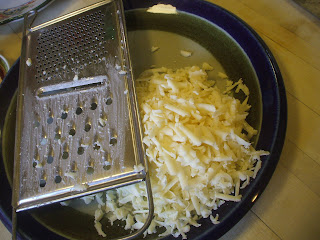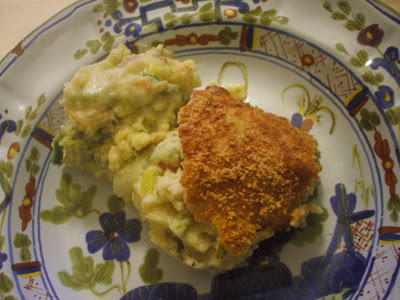Pizza's a big deal for me. I eat Papa John's and Pizza Hut on occasion, it's true, but in general I am indeed a pizza snob. The crust has to be appropriately thin, the toppings fresh, the cheese plentiful but not overwhelming. My go-to crust comes from the NYT and can be found
here. The good news about the NYT recipe is that it makes a crust like no other-- very easy to stretch into shape and wonderfully crisp and golden once cooked. The bad news is that it requires a 24 hour+ rising period. So, when I'm planning on pizza, I go for that recipe. When I'm not, I hunt for another. I have yet to find my perfect "in-a-pinch" pizza dough. Yesterday, I decided to give Jamie Oliver's a try. Jamie's awesome, but the man loves his meat, so when I encounter a recipe of his that doesn't require flesh, I tend to jump on it.
My grandma absolutely loved the crust; she called it rich. I wasn't a huge fan. The dough tasted a bit sweet and was breadier than I like my pizza to be. It's not bad, but it's not fantastic either. The reason I'm blogging this pizza isn't so much for the crust as for the toppings, which I definitely intend to replicate on future pizzas. The crust recipe is
here; I found halving it to be enough for 2 medium/largeish pies
For toppings, I went in two directions, opting for one traditional pizza with tomatoes, cheese, and veggies; and another with a white sauce, caramelized onions, and arugula. The traditional pizza doesn't require much prep work at all; the white pizza, due to the caramelized onions, needs to be thought up at least an hour before baking.
Also, sorry I don't have a lot of prep pictures. We were having company, and it was kinda awkward to play with the iPhone while chatting with guests. :)
Ingredients (Traditional)
-a sprinkling of salt and olive oil
-2 cloves of garlic, minced
-about 6 oz diced tomatoes, preferably fresh but canned will work too
-a handful of fresh basil leaves, torn
-8 oz of sliced mushrooms, sauteed in a little butter with a few torn basil leaves and a minced clove of garlic
-several sun-dried tomatoes, julienned or minced.
-7 oz of grated mozzarella
-1 oz feta cheese, crumbled
-black pepper to taste
 Procedure
Procedure
1) Pre-heat the oven as hot as it'll go. For me, that's 500°F. If your oven gets hotter, all the more power to you. If you're fortunate enough to have a pizza stone, make sure it's in the oven on the lowest shelf, so it can get nice and hot. If not, grease a baking sheet and stick it on the middle rack. Your pizza will be good--just not
as good. On that note, I highly recommend investing in a stone. Even the cheapest ones (I think mine was $25 or so) make a big difference in quality, and they can be used to bake bread as well.
2) I find (clean) hands to be the best way to prep the pizza. Roll out half of the dough (if using Jamie's recipe) to a 1/4 inch circle, or whatever size necessary to fit your pizza stone or baking tray. Use your fingers to pinch the edges all around the dough, creating a ridged side the better to keep the toppings/sauce in place. Put the entire crust on top of a piece of parchment paper, unless of course you have a pizza peel. The parchment paper will ease the process of getting the dough in and out of the hot oven.
3) Start with the olive oil, sprinkling a bit on the dough and using your hand to rub it around. Add more oil if you can't get a little sheen all the way to the edges. Sprinkle on a dash of salt, followed by the minced garlic, the basil, and the tomatoes, trying to get even coverage.
4) Spread a thin layer of mozzarella over the dough, then add the mushrooms, sun-dried tomatoes, feta, and the rest of the mozzarella. Grind black pepper over the top.
5) Bake for about 10 minutes. The best way I've found to get the pizza into the oven is to put the pizza, on top of the parchment paper, onto a large cutting board, pulling the rack with the pizza stone or baking tray as far out of the oven as you can, and carefully tugging the paper onto the stone/sheet. Of course, you want to do this as quickly as possible to preserve the heat, but don't touch the stone or the oven or do anything else that will burn your hands! The crust will grow golden and the cheeses will bubble and perhaps even start to brown in spots.
6) Remove from the oven, let cool for just a moment, slice, and serve.
Ingredients (White)
-White Sauce:
-1 TB butter
-1 TB flour
-1/2 cup milk (I used skim--use whatever you have)
-2 cloves minced garlic
-dashes of salt, pepper, and marjoram
-1 tsp lemon juice
-1 large onion, sliced thinly
-8 oz grated mozzarella
-1/4 cup parmesan cheese
-1 cup baby arugula, tossed in 1 tsp balsamic vinegar
Procedure (White)
1) Prep the caramelized onions. Essentially, you're allowing them to cook slowly enough to really release and celebrate the sugars inside. Take as wide-bottomed a pan or pot as you have and coat with about a TBS of olive oil or butter. When the oil shimmers, add your onions, stirring gently for a few moments, trying to get as many onions to retain surface contact with the bottom as possible. Allow the onions to cook on medium-low heat, stirring often enough to keep them from burning and seldom enough to let them brown. That turned out to be about every 5 minutes, on my stove. After the first 10 minutes, sprinkle the onions with a bit of salt and just the tiniest dash of sugar. The entire process should take at least 30 minutes and up to an hour. Just be patient, and when they look wonderfully brown, remove them from the heat.
 |
| Onions pre-caramelization |
 |
| Onions 15 minutes into cooking |
 |
| Caramelized Onions |
2) Prep the sauce. Melt the butter in a small saucepan over medium heat and stir in the flour quickly, trying to avoid lumps. After a moment, pour in the milk, stirring well. Add a bit of salt and pepper and marjoram, along with the basil and garlic. Let the milk heat gently, stirring often. When it begins to bubble around the sides and thicken, cut the heat.
3) Prep the crust as described above.
4) Spoon the white sauce over the crust, spreading it evenly over the surface. Top with the onions and mozzarella, then sprinkle with black pepper.
5) Bake for about 9 minutes, then pull out of the oven, top with the arugula, and bake for one minute more before pulling out, letting cool very briefly, and serving.






















































